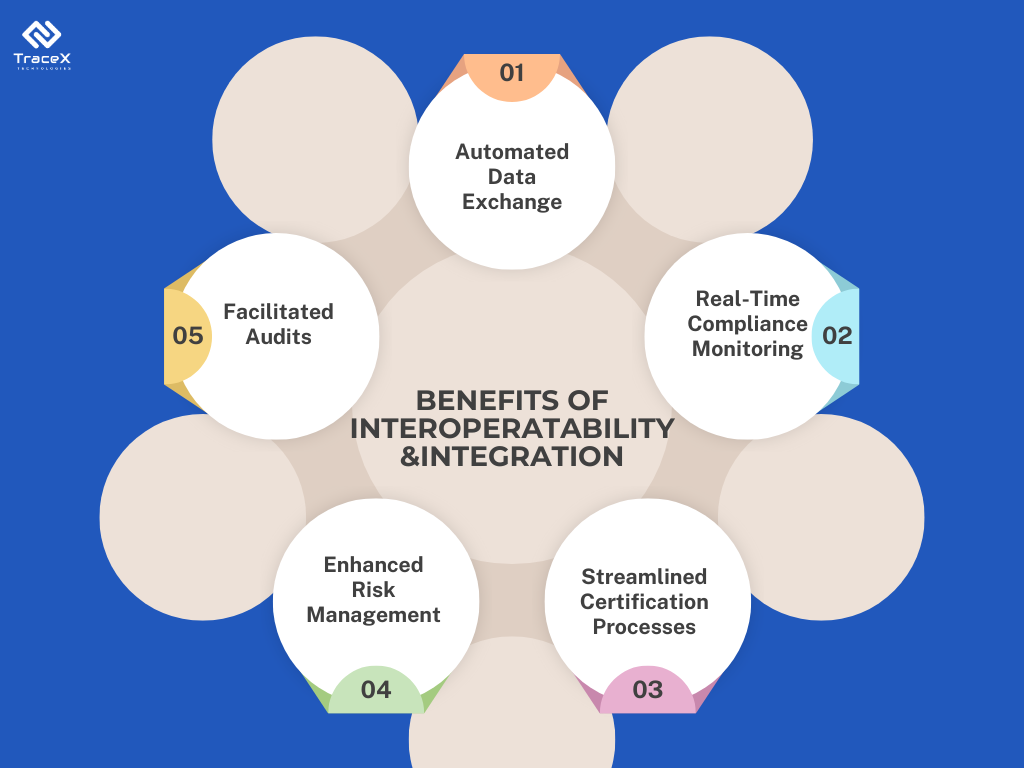Contact: +91 99725 24322 |
Menu
Menu
Quick summary: Discover how interoperability and integration play a crucial role in achieving EUDR compliance and driving sustainability in supply chains. Learn how TraceX's platform leverages blockchain and API integrations for seamless data management and reporting.

Imagine navigating a complex maze, where each turn represents a different regulation, and each dead-end could mean non-compliance, heavy fines, or even a ban from the European market. This is the reality many companies face today as they grapple with the European Union Deforestation Regulation (EUDR). While the regulation is well intentioned, interoperability and integration in EUDR presents a significant challenge for companies.
The EUDR aims to curb deforestation by ensuring that commodities like soy, palm oil, coffee, and rubber entering the EU market are not linked to illegal deforestation. It’s about ensuring that every part of your supply chain, often spanning multiple countries and involving countless stakeholders, is aligned with the stringent requirements of the regulation. This is where interoperability becomes crucial. Without it, businesses are left struggling with fragmented data, inconsistent standards, and the overwhelming complexity of managing a global supply chain.
At its core, interoperability is the ability of different systems, organizations, and applications to work together seamlessly. In the context of EUDR, it refers to the capacity of various entities within the supply chain—ranging from producers and suppliers to regulators and auditors—to share, access, and process data effectively and efficiently. This ensures that all parties are on the same page, using the same data and working towards the same compliance goals.
While interoperability ensures that different systems can work together, integration takes this a step further by ensuring that these systems can operate as a unified whole. In the context of EUDR, integration is essential for creating a seamless and efficient compliance process, particularly when dealing with complex and fragmented supply chains.
Integration is especially important when it comes to aligning internal company systems with external regulatory frameworks like the European Union Due Diligence System (EU-DDS) and other information systems. The EU-DDS is a critical component of the EUDR, providing guidelines and frameworks for due diligence processes that companies must follow to ensure compliance.
Interoperability and integration are essential for effective chain of custody management within the EUDR framework. Seamless data flow between traceability systems and existing IT infrastructure ensures accurate tracking, reduces errors, and enhances compliance efforts.
Interoperability and integration are essential for maintaining supply chain integrity within the EUDR framework. By ensuring seamless data flow and connectivity between traceability systems and other relevant systems, businesses can enhance transparency, reduce errors, and demonstrate compliance with EUDR requirements.
The EUDR was introduced as part of the EU’s broader efforts to combat climate change and biodiversity loss by reducing the EU’s contribution to deforestation. It targets commodities that are often linked to deforestation, such as palm oil, soy, coffee, cocoa, rubber, and beef, requiring companies to provide proof that these products have not contributed to illegal deforestation.
Compliance with EUDR requires companies to implement robust due diligence processes, including risk assessments, traceability, and reporting mechanisms. However, the global nature of supply chains, coupled with the diverse standards and practices across different regions, makes this a daunting task.
For example, a company sourcing palm oil might have suppliers in multiple countries, each with its own set of regulations, certification standards, and data management practices. Ensuring that all this information aligns with the EUDR requirements is a significant challenge, particularly when the systems used by different suppliers are not interoperable.
Interoperability plays a critical role in overcoming these challenges. It enables the integration of various data sources, systems, and standards, ensuring that all stakeholders within the supply chain can access and share the same information. This is particularly important in the context of EUDR, where transparency and traceability are key.
Here are some ways in which interoperability can enhance EUDR compliance:
Interoperability allows for the seamless integration of data from different sources, making it easier to collect, share, and analyze information across the supply chain. For instance, interoperability enables a platform to aggregate geolocation data from farms, processing units, and transportation hubs, regardless of the data source. This integration allows companies to monitor deforestation risks, ensure that sourcing regions are compliant with environmental regulations, and verify that all points in the supply chain adhere to the standards set forth by the EUDR. By collecting, sharing, and analyzing this data in a unified manner, businesses can enhance transparency, improve decision-making, and maintain a compliant and sustainable supply chain
Traceability is crucial for EUDR compliance. Interoperable systems enable companies to track the origin of commodities from farm to fork, ensuring that they can verify compliance with the regulation.
When systems are not interoperable, there is a higher risk of errors and inconsistencies in the data. This can lead to non-compliance and penalties. Interoperability helps to eliminate these risks by ensuring that all systems are aligned and that data is consistent across the supply chain.
EUDR requires companies to provide detailed reports on their supply chain practices. Interoperable systems make it easier to generate these reports by consolidating data from various sources. This not only saves time but also ensures that the reports are accurate and compliant with the regulation.
The EU-DDS sets out specific due diligence requirements that companies must meet, including risk assessments, traceability, and reporting. Integrating your internal systems with the EU-DDS ensures that your compliance efforts are aligned with the regulatory requirements, reducing the risk of non-compliance.
Integration allows for the centralization of data from various sources, both internal and external. This ensures that all data is consistent, up-to-date, and easily accessible for compliance reporting and audits.
By integrating data from different systems, companies can gain a comprehensive view of their supply chain, enabling better decision-making.
Integration with external information systems, such as those used by regulatory bodies or certification organizations, can streamline the reporting process.
Integration facilitates collaboration with external stakeholders, such as suppliers, auditors, and regulators. By ensuring that all parties have access to the same data and are using compatible systems, integration promotes transparency and trust within the supply chain.
For companies seeking to achieve full compliance with the EUDR, integrating their systems with the EU-DDS and other relevant information systems is not just beneficial—it’s essential.

Technology plays a crucial role in overcoming the challenges of interoperability and integration, enabling companies to achieve seamless compliance with the EUDR. Here are some of the key technologies that can facilitate interoperability and integration:
Blockchain allows all stakeholders in the supply chain—from producers to retailers—to access a single, secure source of truth. This eliminates discrepancies caused by siloed data and ensures that everyone is working with the same information, regardless of the systems they use. Every transaction and data point recorded on the blockchain is immutable, meaning it cannot be altered or tampered with. This feature ensures that all compliance-related data is accurate, trustworthy, and auditable, which is essential for EUDR compliance. Blockchain inherently supports standardized data formats, making it easier to integrate with various systems and platforms used by different supply chain stakeholders. This standardization is a key factor in achieving interoperability across diverse ecosystems.
TraceX’s platform is designed to integrate seamlessly with external systems, such as the EU Due Diligence System (EU-DDS), certification bodies, and other information systems. Through API integrations, data can flow smoothly between TraceX and these external platforms, ensuring that all compliance data is up-to-date and consistent across the board. APIs facilitate real-time data exchange, allowing TraceX to pull in information from various sources and push updates as needed. This real-time capability is crucial for maintaining compliance with dynamic regulatory requirements like those under EUDR. TraceX’s platform can also integrate with a company’s internal systems, such as ERP or supply chain management software. This ensures that data flows seamlessly within the organization, reducing the risk of errors and ensuring that all systems are aligned with EUDR compliance goals.
With all data centralized and standardized through blockchain, TraceX can automate the generation of compliance reports required under the EUDR. This reduces the administrative burden on companies and ensures that reports are consistent and error-free. The platform’s integration capabilities ensure that all data is up-to-date and compliant with regulatory requirements, making it easy to prepare for audits. The immutable nature of blockchain records further strengthens the audit process, providing a clear and traceable record of all supply chain activities.
Through its blockchain infrastructure, TraceX provides all stakeholders with shared access to relevant data. This transparency fosters trust and cooperation, ensuring that everyone is working towards the same compliance goals. By offering API integrations, TraceX ensures that all stakeholders, including suppliers, regulators, and auditors, can connect their systems with the platform. This integration enhances communication and ensures that all parties are aligned.
The platform’s blockchain architecture is scalable, allowing it to handle increasing volumes of data and transactions as supply chains expand or become more complex. TraceX’s API framework is designed to be flexible, allowing for the integration of new systems or the adaptation to new regulatory requirements without major overhauls. This future-proofs the platform and ensures long-term compliance.
Explore our EUDR Compliance Platform
As the European Union Deforestation Regulation (EUDR) imposes more stringent requirements on supply chains, the importance of interoperability and integration cannot be overstated. By embracing technologies like blockchain and leveraging powerful API integrations, companies can ensure seamless data flow, accurate compliance reporting, and enhanced collaboration among stakeholders. TraceX’s EUDR Compliance Platform offers a comprehensive solution to these challenges, enabling businesses to not only comply with regulations but also drive sustainable practices throughout their supply chains. As the regulatory landscape continues to evolve, adopting these innovative solutions will be crucial for achieving long-term compliance and sustainability goals.
Interoperability refers to the ability of different software systems and platforms to communicate and exchange data seamlessly. In the context of EUDR, interoperability is essential for ensuring that traceability solutions can integrate with existing supply chain management systems, ERP systems, and other relevant software. This enables efficient data flow, reduces manual errors, and enhances overall compliance efforts.
Integrating traceability solutions with existing systems can provide several benefits, including:
– Streamlined data flow: Reducing manual data entry and minimizing errors.
– Enhanced decision-making: Accessing comprehensive data for informed insights.
– Improved efficiency: Optimizing operations and reducing costs.
– Better collaboration: Fostering stronger communication and coordination within the supply chain.
Achieving interoperability can present challenges, such as:
– Data standards: Ensuring compatibility between different data formats and standards.
– Technical complexity: Addressing the technical challenges of integrating systems.
– Cost and time: Investing in the necessary resources and expertise.
– Vendor support: Ensuring that software vendors provide adequate support for integration.
By carefully considering these factors, businesses can overcome challenges and successfully implement interoperability solutions for EUDR compliance.
